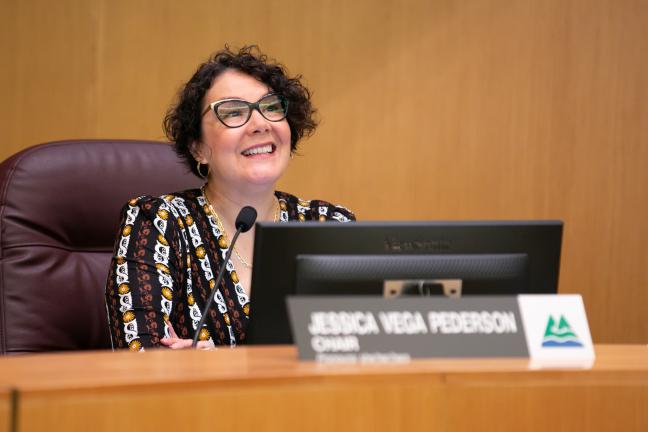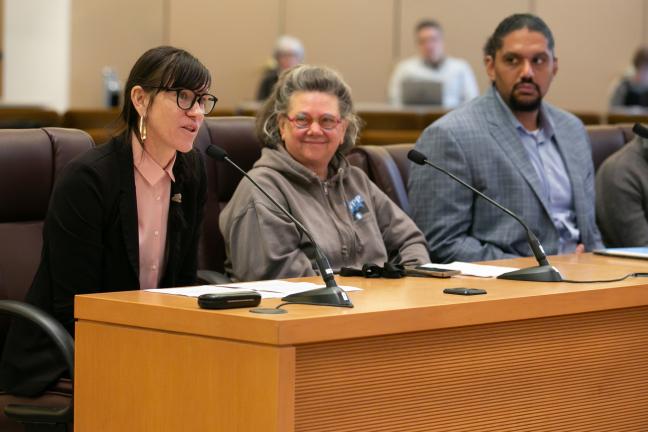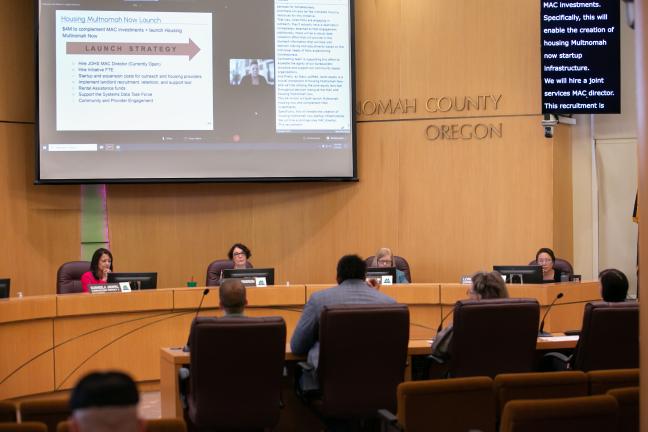The Board of Commissioners on March 16 approved $4 million for a pilot project addressing unsheltered homelessness that will move hundreds of people directly from tents to apartments.
The funding, approved 4-0, comes from the Supportive Housing Services measure, and aims to cover start-up costs for the program through June 2023.
Chair Jessica Vega Pederson first announced the pilot project — called Housing Multnomah Now — in February. It will focus on specific geographic areas, using an interagency unified command center to create a by-name list, direct targeted outreach, navigate around barriers, and provide affordable housing to people living unsheltered.
“Housing Multnomah Now builds on prior County work like Move-In Multnomah, a successful effort that placed unhoused people in housing units by offering guaranteed rent and landlord incentives, and did so at a fraction of the cost of other shelter options,” Vega Pederson said.
Modeled after a pilot program now underway in Seattle, Housing Multnomah Now builds on the housing-first work of the Joint Office of Homeless Services, which helped 11 people a day move into housing over the last three months of 2022. Housing Multnomah Now aims to move 300 people into housing in its first year.
The funding approved March 16 will pay for start-up costs through the end of the current fiscal year, June 30, and allow the Joint Office of Homeless Services to launch the plan. The funds will cover the cost of three full-time employees, initial landlord recruitment and retention, and rental assistance for 100 people, along with work to build provider capacity and add more community engagement.
Additional funding is anticipated to be provided by the state, as the plan was created in line with Gov. Tina Kotek’s January 2023 executive orders directing emergency funding to solutions to homelessness statewide. That funding will allow the program to expand after the start-up period.
To apply for and receive state emergency funds, Gov. Kotek’s project calls for regions like Portland and Multnomah County to build collaborative workgroups and devise plans for rapidly housing and sheltering hundreds of people, while also preventing thousands of evictions. Housing Multnomah Now will be the primary vehicle for the local workgroup tasked with investing state emergency funding, Chair Vega Pederson said.
“It is through this effort that we’ll be eligible for additional state funding which will expand the capacity of our efforts and get more people safely off our streets. That is our north star,” she said.
Housing-first approach garners support from community partners
Building upon the evidence-based model of housing-first — which aims to rapidly place people into permanent housing but also provide crucial wraparound supports as needed — Housing Multnomah Now brings added urgency and focus to the Joint Office’s larger strategy.
Joshua Bates, interim director of the Joint Office, said the combination of targeted outreach, along with having housing units identified and available for program participants, will make an impact on unsheltered homelessness in the geographic areas the program focuses on.
“There will be outreach teams fully dedicated to this effort, which will cultivate those important relationships with folks experiencing homelessness that will lead to them receiving housing, which is really the cure and the panacea for homelessness,” Bates said. “There will also be dedicated housing resources for this initiative. That way, when folks are engaging in outreach, they'll actually have a destination immediately attached to that engagement.”
Similar to Move-in Multnomah, Housing Multnomah Now will ensure it has dedicated housing options through landlord recruitment and incentives.
Molly Hogan, director of the Welcome Home Coalition, an advocacy group focused on solutions to homelessness, presented at the meeting and described the housing-first model as cost-effective and humane.
“Research continues to show that housing people is the most effective, cost-effective policy,” Hogan said, pointing to data that the Joint Office’s Move-In Multnomah pilot was cheaper than congregate shelters, with permanent housing costing $52 a day per household versus $55 to $68 a day for congregate shelter.
While the Joint Office continues to expand the shelter system with new beds, including traditional congregate shelters along with motel and village and safe park shelters, the ultimate goal is for shelter stays to be temporary and a path into housing.
Hogan shared a personal story showing the impact of a housing-first approach like Housing Multnomah Now. Hogan’s mother was homeless and unsheltered for a decade. Not wanting to give up her autonomy, her mother chose to live in a tent rather than stay in a congregate shelter.
“What finally stabilized her was a subsidized apartment, which I’m really happy to report she’s still living in, on her $900-a-month fixed income,” Hogan said. “Investing in rent assistance and more affordable housing is life-changing for so many, and I’m grateful to see the County choosing this.”
Laura Golino de Lovato, executive director of Northwest Pilot Project, which works to house seniors, also spoke in support of the funding. Bobby Weinstock, a senior leader at Northwest Pilot Project, was an early champion for work that eventually led to the creation of locally funded long-term rent assistance vouchers.
“It’s critical to invest in solutions that prioritize permanent housing placements, and person-centered services. And that’s why we support Chair Vega Pederson’s Housing Multnomah Now proposal,” Golino de Lovato said.
Community members who signed up for public testimony were also largely supportive. Michelle Hornbeck, a peer support specialist who is part of the Welcome Home Coalition, shared her experience with homelessness and said moving into housing changed her life.
“What I have found, since I moved into my new affordable housing, is that I feel better. I'm more productive. I eat better," Hornbeck said. “But it's so vitally important, because we're homeless. We don't think about going to the doctor. We don't care if we just eat a bag of chips and a soda pop for the day. It is so vitally important, and you can't ask people to be productive if they don't even have the security of where they're going to lay their head.”
Housing Multnomah Now in alignment with Gov. Kotek’s efforts to end homelessness in Oregon
Stacy Borke, Chair Vega Pederson’s senior policy advisor on homelessness, shared how Housing Multnomah Now fits into Gov. Kotek’s plan to urgently address homelessness statewide.
Like Housing Multnomah Now, Borke said executive orders signed in January calling for action and funding to reduce homelessness, bring “urgency, attention and focus toward moving people off the street and back into housing, and then helping them keep that housing.”
Housing Multnomah Now will guide the direction of Multnomah County’s newly created Multi-Agency Coordinating group. Kotek, in one of her January emergency declarations, called for the creation of multiple coordinating groups at the local, regional and state levels to reduce unsheltered homelessness, increase shelter access and efficacy, and prevent more people from becoming homeless.
A structure borrowed from emergency management practices, the interagency groups are tasked with acting urgently to prevent and reduce homelessness.
Kotek has outlined that the Multnomah County MAC will be responsible for helping 2,000 households keep their housing, adding 150 shelter beds across the community, and helping 300 people move from homelessness back into housing before January 2024.
Housing Multnomah Now was designed as the mechanism for achieving some of those goals. Because of its alignment with the governor’s project, Housing Multnomah Now is anticipated to receive additional emergency funding through the state, part of a $200 million package currently advancing in the Oregon Legislature.
Cole Merkel, co-director of the advocacy group HereTogether, shared his support, highlighting the multi-agency nature of Housing Multnomah Now as effective.
“We believe that Housing Multnomah Now really does hold the promise to develop a highly collaborative response to our region’s homelessness crisis by leveraging and adding to the tools we already have, while adhering to proven solutions that center the unique needs and personal autonomy of our neighbors on the streets,” Merkel said. “This is a great opportunity to coordinate systems, partners, and data, and put our resources and focus on a shared goal: A future where homelessness is rare and brief.”
Commissioners ask questions about sustainability and scope of pilot
Both community partners and County Commissioners wondered what would follow the pilot, asking how the Joint office would ensure the program remains funded beyond the initial start-up period.
While longer-term funding must still be secured, Bates said it fits within the larger body of work for the Joint Office.
“Housing Multnomah Now is a vehicle for these housing placements — it’s really within the overall system of the Joint Office of Homeless Services, and our continuum of care. This is not something that’s going to be isolated and siloed,” Bates said. “We’re looking at how we can leverage the other systems and other parts of the Joint Office to be able to provide housing for those folks as long as they need it.”
Commissioners also highlighted that Housing Multnomah Now alone won’t in itself solve the region’s homelessness crisis.
“While I do support this program, it is not going to solve all of our problems. While I’m appreciative of the governor's investment in homeless services, which is unprecedented at the state level, that is not going to solve all of our homelessness issues,” Commissioner Lori Stegmann said. “It’s not one single individual strategy that's going to get us where we need to go.”
Commissioner Diane Rosenbaum acknowledged Housing Multnomah Now isn’t a standalone solution, but praised its design. “It’s not a complete solution by any means, but it's a good start, and well thought out,” Rosenbaum said. “The combination of prevention — keeping people in housing — and providing new placements is good. The data collection is definitely good, so we'll know how well we're doing.”
Commissioner Susheela Jayapal praised the urgency of the plan, even as she acknowledged its limitations given the need for services and housing that will remain in the community.
“It will, I believe, have an impact on unsheltered homelessness, both for the people who are experiencing it and for the community that's understandably concerned and frustrated by it,” Jayapal said.
Additionally, she said that the program will help identify and clear roadblocks in the system, improving access to housing that will have an impact beyond the 300 people expected to be served this year by the pilot.
“As we move these 300 people, for each of them, we're going to be fixing a system. And that's going to teach us something about how we continue to fix our systems going forward,” Jayapal said.
Chair Vega Pederson said one of the goals of the pilot is to identify any problem areas and improve the system as a whole.
“We need to be using this as an opportunity to create something more permanent, to create a stronger system, to create stronger collaboration — breaking down the silos and some of the inefficiencies in our system that are preventing us from serving as many people in the best way possible,” she said. “So no, it's not a solution that's going to solve all of the problems, but it's going to be an investment that is going to help us do that work more broadly.”



